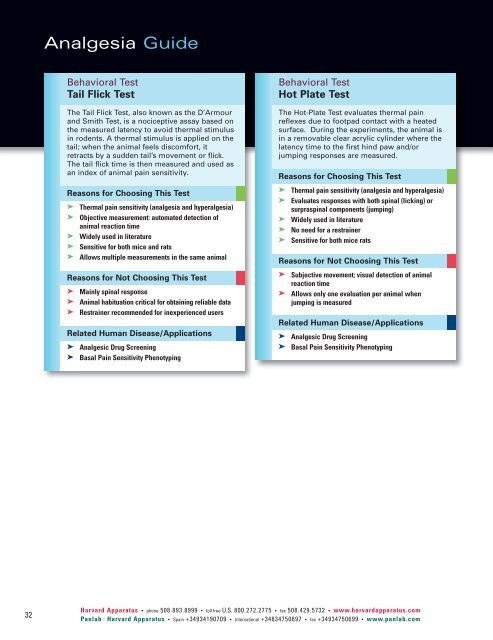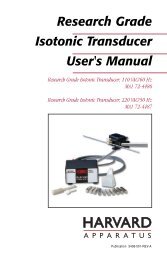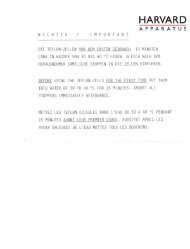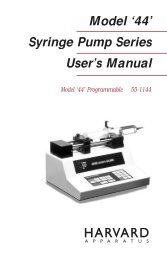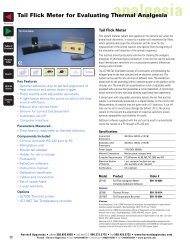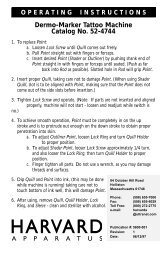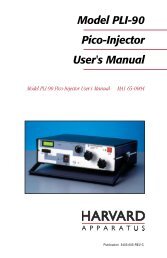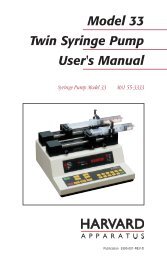View Catalog PDF - Harvard Apparatus
View Catalog PDF - Harvard Apparatus
View Catalog PDF - Harvard Apparatus
Create successful ePaper yourself
Turn your PDF publications into a flip-book with our unique Google optimized e-Paper software.
Analgesia Guide<br />
Behavioral Test<br />
Tail Flick Test<br />
The Tail Flick Test, also known as the D’Armour<br />
and Smith Test, is a nociceptive assay based on<br />
the measured latency to avoid thermal stimulus<br />
in rodents. A thermal stimulus is applied on the<br />
tail; when the animal feels discomfort, it<br />
retracts by a sudden tail’s movement or flick.<br />
The tail flick time is then measured and used as<br />
an index of animal pain sensitivity.<br />
Reasons for Choosing This Test<br />
➤ Thermal pain sensitivity (analgesia and hyperalgesia)<br />
➤ Objective measurement: automated detection of<br />
animal reaction time<br />
➤ Widely used in literature<br />
➤ Sensitive for both mice and rats<br />
➤ Allows multiple measurements in the same animal<br />
Reasons for Not Choosing This Test<br />
➤<br />
➤<br />
➤<br />
Mainly spinal response<br />
Animal habituation critical for obtaining reliable data<br />
Restrainer recommended for inexperienced users<br />
Related Human Disease/Applications<br />
➤<br />
➤<br />
Analgesic Drug Screening<br />
Basal Pain Sensitivity Phenotyping<br />
Behavioral Test<br />
Hot Plate Test<br />
The Hot-Plate Test evaluates thermal pain<br />
reflexes due to footpad contact with a heated<br />
surface. During the experiments, the animal is<br />
in a removable clear acrylic cylinder where the<br />
latency time to the first hind paw and/or<br />
jumping responses are measured.<br />
Reasons for Choosing This Test<br />
➤ Thermal pain sensitivity (analgesia and hyperalgesia)<br />
➤ Evaluates responses with both spinal (licking) or<br />
surpraspinal components (jumping)<br />
➤ Widely used in literature<br />
➤ No need for a restrainer<br />
➤ Sensitive for both mice rats<br />
Reasons for Not Choosing This Test<br />
➤<br />
➤<br />
Subjective movement; visual detection of animal<br />
reaction time<br />
Allows only one evaluation per animal when<br />
jumping is measured<br />
Related Human Disease/Applications<br />
➤<br />
➤<br />
Analgesic Drug Screening<br />
Basal Pain Sensitivity Phenotyping<br />
32<br />
<strong>Harvard</strong> <strong>Apparatus</strong> • phone 508.893.8999 • toll free U.S. 800.272.2775 • fax 508.429.5732 • www.harvardapparatus.com<br />
Panlab | <strong>Harvard</strong> <strong>Apparatus</strong> • Spain +34934190709 • International +34834750697 • fax +34934750699 • www.panlab.com


